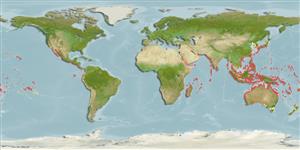Common names from other countries
Classification / Names / Names
Nomes comuns | Sinónimos | Catalog of Fishes (gen., sp.) | ITIS | CoL | WoRMS
Environment: milieu / climate zone / depth range / distribution range
Ecologia
. Tropical
Indian Ocean: from Egypt to Mozambique, including the Red Sea, Seychelles, Madagascar, Mauritius, Réunion, Rodrigues and Mascarene Islands, east to India and south to Dampier, Western Australia, including Andaman Sea, Laccadive Islands, Maldives, Sri Lanka and Nicobar Islands; Pacific Ocean: from China to the south China Sea, south to New Zealand, including Federated States of Micronesia, Fiji, Norfolk Islands, the Great Barrier Reef, Lord Howe Island, Tasmania and French Polynesia, east to Chile, including Samoan Archipelago and Hawaiian Islands.
Length at first maturity / Tamanho / Peso / Idade
Maturity: Lm ? range ? - ? cm
Thallus forming a dark green, amorphous to convoluted spongy mass, composed of central medulla and cortex. Medulla consisting of branched cylindrical filaments, their tips inflated into cylindrical to clavate utricles forming the cortex.Hairs or hair scars occur in 1 to 3 vertical rows, at some distance from the tip of the utricle. Gametangia cylindrical and tapering towards both ends, borne at the side of the proximal portion of the utricle. Amorphous clumps up to 5 cm in diameter (Ref. 80758).
Used for human consumption and as medicine (Ref. 80758). Inhabits lower intertidal to shallow subtidal areas where it grows encrusted on sandy-rocky substrate or epiphytic on stipes of larger seaweeds and midribs of the seagrass Enhalus (Ref. 80758).
Guiry, M.D. and G.M. Guiry. 2009. (Ref. 80701)
Categoria na Lista Vermelha da IUCN (Ref. 130435)
Categoria CITES (Ref. 108899)
Not Evaluated
Not Evaluated
Ameaça para o homem
Utilização humana
Pescarias: espécies comerciais
| FishSource |
Ferramentas
Mais informação
Idade/TamanhoCrescimentoComprimento-pesoComprimento-comprimentoMorfologiaLarvasAbundância
Fontes da internet
Estimates based on models
Preferred temperature
(Ref.
115969): 24.6 - 29.3, mean 28.4 (based on 2952 cells).
